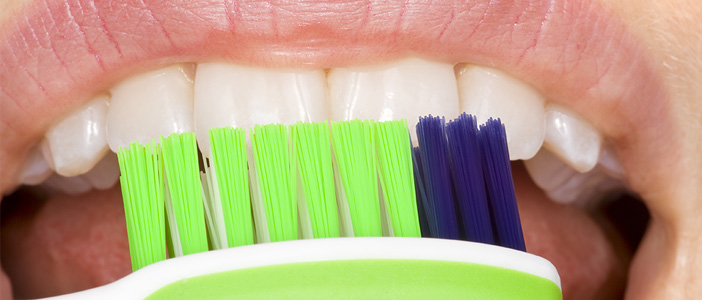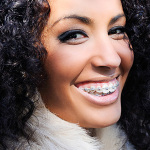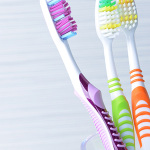Oral Hygiene for the Orthodontic Patient
By: Columbia University College of Dental Medicine
If you thought brushing and flossing were important before you got braces…well, you were right. But people undergoing orthodontic treatment need to be even more dedicated to good oral hygiene. Read more about how to properly care for your braces, including brushing & flossing techniques, eating right, and caring for your retainer.
“Braces trap food very easily, which contributes to plaque formation,” says Thomas Cangialosi, D.D.S. “If plaque is not carefully removed from teeth and from around braces, patients run the risk of developing gum disease, dental decay and bad breath.” Dr. Cangialosi is chairman and professor of Orthodontics at the University of Medicine and Dentistry of New Jersey.
Plaque is a mixture of bacteria, debris and bits of food. The bacteria feed on sugars and produce acids. The acids can irritate your gums, erode the enamel on your teeth and contribute to bad breath (halitosis).
It’s important to remove the plaque thoroughly and often. Then, when your braces come off, the surfaces of your teeth underneath the braces will be healthy and strong and look good. Here are some tips to help you.
Brushing
Use a soft-bristle toothbrush. Soft bristles are better than medium or hard bristles at getting into those nooks and crannies around your braces. They also don’t irritate your gums.
Some companies make toothbrushes especially for people with braces. Known as bi-level brushes, they have longer bristles on the edges and shorter ones in the middle. This type of brush allows you to clean the area above and below the brackets and the brackets as well.
The most important thing is to look for a brush that’s soft and approved by the American Dental Association (ADA). After that, the size of the brush, the shape of the handle and other variations are up to you.
Brush at least three times a day.
What about an electric toothbrush? It’s not necessary, but if you have one, it’s safe to use it on your braces. Just be careful not to hit the plastic back of the brush against the brackets on your braces because it can damage them. Also, it should be used on a moderate setting so as not to break or loosen braces.
Brush at least three times a day. It is best to brush after meals to make sure there’s no food trapped in or around braces. If you are not able to brush after lunch, at least rinse your mouth with water very thoroughly.
Brush for at least two to three minutes each time. It’s best to use a watch or timer to make sure you are brushing long enough.
“Brushing should be done slowly and carefully,” says Dr. Cangialosi. “It’s important to brush the braces and all the surfaces of the teeth, that is, the inside and outside surface and the chewing surfaces, too. Pay special attention to the areas between your brackets and your gums.”
Flossing
Floss at least once a day. It might seem like you can’t possibly floss while you have braces, but you can and you should. Special flossing products can help you get into the space between the wires and your gumline. These include floss threaders and a special kind of floss. When your braces are first put on, someone in your orthodontist’s office should review flossing techniques. If you’re not sure you’re doing it right, ask your orthodontist during your next visit.
Fluoride
Use a fluoride toothpaste. It doesn’t really matter which one — just make sure it has the ADA seal of approval.
Your orthodontist may recommend that you use an over-the-counter fluoride rinse. These rinses usually provide enough fluoride to help protect and strengthen teeth during orthodontic treatment. However, if you have a history of cavities or are otherwise at risk of decay, your orthodontist may prescribe a rinse that contains more fluoride, Dr. Cangialosi says.
Consider an office treatment. You can get more fluoride — usually in the form of a gel or varnish — from your dentist during a regular visit. If you have a history of decay, your dentist may suggest this type of treatment. During orthodontic treatment, see your family dentist for a complete examination every six months, or as directed by your dentist.
Tools To Help You
Rubber-tipped and end-tuft or single-tuft brushes — These are special brushes that help you to get into those nooks and crannies, as well as between your teeth. The end-tuft or single-tuft brushes look something like pipe cleaners.
Oral irrigators — These instruments shoot small streams of water onto your teeth at high pressure to remove bits of food. “They can be used as an aid in your oral hygiene practice, but not in place of brushing and flossing,” Dr. Cangialosi says. They also should be used at a moderate setting so they don’t damage the braces.
Antibacterial rinses — These rinses are fine for adults, but their high alcohol content makes them off-limits for kids. “There are alcohol-free rinses available for children to use,” Dr. Cangialosi says. “But some are designed only to freshen breath and not to kill bacteria. Before buying an antibacterial rinse for your child to use, you should ask your orthodontist which rinses he or she recommends.”
Disclosing solutions or tablets — Your dentist may have used these during an office visit to see where you tend to miss spots after brushing. Disclosing tablets and solutions use vegetable dye to highlight plaque or debris in your mouth. “Once you see the spots, you can quickly remove them with your toothbrush,” Dr. Cangialosi says. You can find them in a drugstore or get some from your dentist and use them at home.
If you have questions about how to use any oral hygiene product, even your toothbrush, call your orthodontist’s office or talk to someone there during your next visit.
Caring for your Retainer
If you have a retainer or other removable orthodontic appliance, it needs to be cleaned regularly, too. After all, it spends a lot of time in your mouth.
Brush the appliance daily with your soft toothbrush and some toothpaste. This is especially important for the side that is in contact with the roof of your mouth or gums. Brush your retainer over a wash bowl filled with a few inches of water. That way, if it slips out of your hand it will not be damaged. You also can soak it in a cleaning solution. There are several that are advertised as denture cleaners. If you want to soak your retainer, talk to your orthodontist about which solution to use. Some cleaning solutions can corrode wires or other metallic areas on orthodontic appliances.
When brushing or soaking your appliance, never use hot water. It can distort the plastic and make the appliance unusable. When your retainer is not in your mouth, keep it in the case that your orthodontist gave you. Also, keep it away from your pets. Dogs and cats love the plastic and will chew it to bits if they get it.
Eating Right
While you’re wearing braces, you need to think twice about eating foods that could increase your risk of cavities. You also should avoid anything that might damage your brackets or wires. Frequently breaking your braces will add to the overall treatment time.
Frequent snacking on sugary foods is worse than eating those foods with a non-sugary meal.
Stay away from hard and sticky foods. Caramel, hard candy, gum – you get the idea. They can damage your braces and get stuck in the wires and brackets. While the food’s stuck there, it provides lots of sugar for cavity-causing bacteria to munch on. Also, do not chew on ice cubes.
Cut down on all sugary foods. You can still have a limited amount of sweets and soda, but the more sugars you eat, the greater your risk of tooth decay. Always brush after eating sugary foods or candy.
It’s not just what you eat, but also when you eat it. Frequent snacking on sugary foods is worse than eating those foods with a non-sugary meal. Don’t eat sugary foods or candy before going to bed without brushing. The more chances you give the bacteria to turn sugars into acids, the higher your risk of decay.
Original Article: http://www.simplestepsdental.com/SS/ihtSS/r.==/st.32578/t.32586/pr.3.html
Biermann Orthodontics is a cutting-edge orthodontic practice that serves Beaverton and Molalla, OR, and focuses on providing world-class customer service and efficient treatment. We strive to create stunning smiles in the shortest amount of time without ever sacrificing quality.
Visit our Locations page to find a clinic near you, or schedule an initial consultation.
Biermann Orthodontics
503-690-0722
17885 NW Evergreen Parkway, Suite 200
Beaverton, OR 97006



